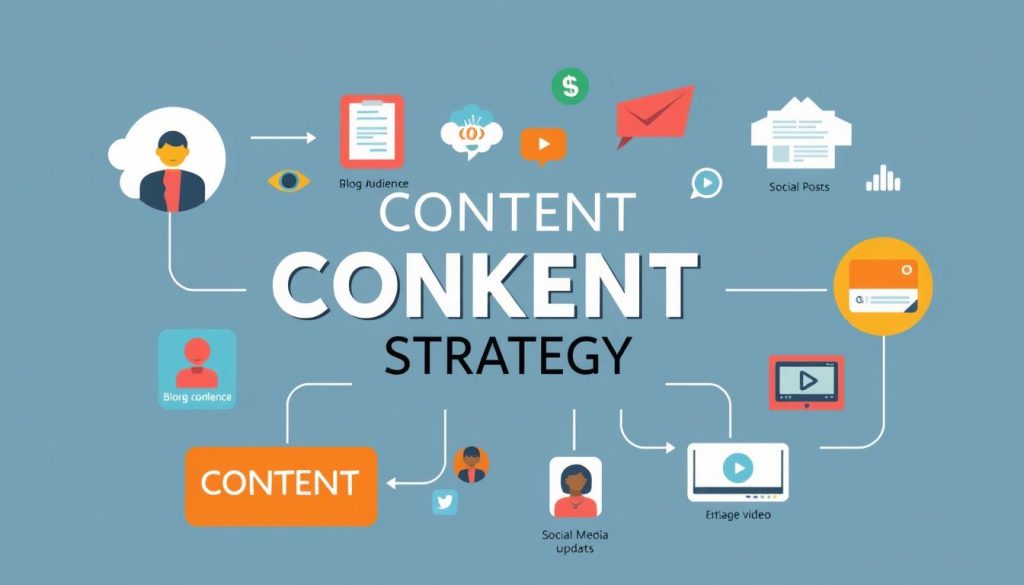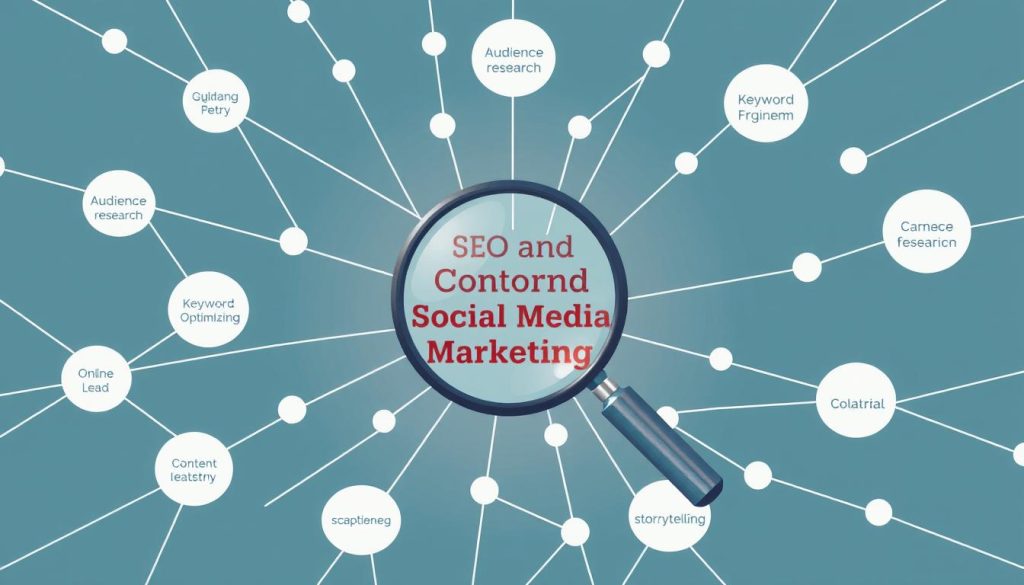In today’s digital landscape, businesses must adapt their marketing strategies to effectively engage and convert potential customers. One powerful approach that has emerged as a game-changer is content marketing. By leveraging informative, valuable, and engaging content, companies can attract, educate, and nurture leads, ultimately driving them towards conversion.
This article delves into the world of content marketing, exploring how it can be strategically employed to capture leads online. From understanding the core principles of content marketing to developing a comprehensive strategy, we’ll uncover the essential elements that transform content into a powerful lead generation tool.
Key Takeaways
- Content marketing is a strategic approach that uses valuable, relevant, and consistently published content to attract and retain a clearly defined audience.
- Effective content marketing can significantly improve lead generation by educating, engaging, and nurturing potential customers.
- Developing a content marketing strategy involves identifying your target audience, setting measurable goals, and aligning content creation with your business objectives.
- Various content types, such as blogs, whitepapers, webinars, and social media posts, can be leveraged to capture leads online.
- Content promotion strategies, including search engine optimization (SEO) and social media marketing, are crucial for ensuring your content reaches the right audience.
What is Content Marketing?
Content marketing is a strategic approach that focuses on creating and distributing valuable, relevant, and consistent content to attract and retain a clearly defined audience. This powerful marketing technique aims to establish trust, build brand awareness, and nurture leads through the sales funnel by providing potential customers with informative and engaging content.
Definition and Key Components
At its core, content marketing involves identifying the target audience, setting measurable goals, developing a comprehensive content plan, and consistently measuring the performance of the content initiatives. The key components of an effective content marketing strategy include:
- Audience research and persona development
- Establishing clear, data-driven marketing objectives
- Creating a diverse content mix (e.g., blog posts, videos, infographics, whitepapers)
- Optimizing content for search engine visibility and social media engagement
- Monitoring and analyzing content performance metrics
Benefits of Content Marketing for Lead Generation
Content marketing can be highly effective in capturing leads online by positioning the brand as a trusted industry authority and educating potential customers throughout their buyer’s journey. Some of the key benefits of leveraging content marketing for lead generation include:
- Increased brand awareness and thought leadership
- Improved lead quality and conversion rates
- Enhanced customer engagement and loyalty
- Reduced acquisition costs compared to traditional advertising
- Valuable data and insights for optimizing marketing efforts
| Key Benefits of Content Marketing | Description |
|---|---|
| Increased Brand Awareness | Content marketing helps establish the brand as an industry authority, building trust and credibility with the target audience. |
| Improved Lead Quality | By providing valuable content, the brand can attract and engage with leads that are more likely to convert into customers. |
| Enhanced Customer Loyalty | Consistently delivering high-quality content helps foster deeper relationships and repeat business with customers. |
Developing a Content Marketing Strategy
Crafting an effective content marketing strategy begins with understanding your target audience. This involves researching their pain points, interests, and preferred content formats. By delving into the needs and preferences of your target audience, you can create content that resonates with them and addresses their specific challenges.
Identifying Your Target Audience
To effectively identify your target audience, consider the following factors:
- Demographic information (age, gender, location, income, etc.)
- Psychographic data (interests, values, lifestyle, pain points)
- Preferred content formats (blog posts, videos, infographics, podcasts)
- Platforms and channels they engage with (social media, search engines, industry publications)
Setting Measurable Goals
Once you have a clear understanding of your target audience, the next step is to set measurable goals for your content marketing efforts. These goals should be specific, achievable, and aligned with your overall business objectives. Examples of measurable goals include:
- Increasing website traffic by 20% over the next 6 months
- Generating 50 qualified leads per month through gated content offers
- Improving conversion rates on landing pages by 15% within the next quarter
By setting these types of goals, you can track the success of your content marketing strategy and make data-driven decisions to optimize your efforts over time.

“Successful content marketing is not about creating more content, but about creating more of the right content.”
Content Types for Lead Capture
In the world of content marketing, there is a vast array of content types that can be leveraged to capture leads online. From the classic blog post to the engaging webinar, each format has its unique strengths and appeals to different segments of your target audience. The key is to create content that provides genuine value and encourages your audience to engage, share, and ultimately convert into leads.
Some of the most effective content types for lead capture include:
- Blog posts – Informative, educational articles that establish your brand as an industry authority and draw in potential leads.
- E-books and whitepapers – In-depth, gated content that offers your audience substantive information in exchange for their contact details.
- Webinars – Live or recorded video presentations that allow you to showcase your expertise and encourage sign-ups.
- Videos – Visually engaging content that can be used to educate, entertain, and compel your audience to take action.
- Case studies – Detailed accounts of your work with past clients, demonstrating your capabilities and driving lead generation.
- Interactive tools – Calculators, quizzes, and other interactive experiences that capture user information and generate qualified leads.
Regardless of the content type, the key is to create material that your target audience finds genuinely valuable and relevant to their needs. By providing this kind of content, you can effectively capture leads and take the first step towards converting them into loyal customers.
| Content Type | Key Benefit for Lead Capture |
|---|---|
| Blog Posts | Establish authority, attract organic traffic, and encourage lead conversion |
| E-books and Whitepapers | Offer valuable, gated content in exchange for user information |
| Webinars | Showcase expertise, build relationships, and generate qualified leads |
| Videos | Engage audiences, demonstrate products/services, and drive lead generation |
| Case Studies | Highlight past successes and convert leads through social proof |
| Interactive Tools | Capture user information and generate qualified leads through engaging experiences |

“The key to successful lead capture is to create content that your target audience truly values and wants to engage with. By providing this kind of content, you can build trust, authority, and a loyal customer base.”
Using Content Marketing to Capture Leads Online
To capture leads using content marketing, businesses can leverage gated content offers. These are valuable resources that users can access in exchange for their contact information. By offering compelling content like free e-books, webinars, or exclusive industry reports, businesses can encourage users to provide their personal details and become leads.
Gated Content Offers
Gated content offers are a powerful way to capture leads online. By requiring users to fill out a form or provide their email address before accessing the content, businesses can gather valuable lead information. This approach works well because users are willing to exchange their contact details in return for high-quality, exclusive content that addresses their needs and pain points.
Lead Magnets and Opt-In Incentives
In addition to gated content, businesses can also use lead magnets and opt-in incentives to capture leads. Lead magnets are enticing offers like free e-books, webinars, or industry reports that are designed to attract and convert potential customers. Opt-in incentives, such as discounts or free trials, can also be effective in encouraging users to provide their personal information and become leads.
By leveraging these content marketing strategies, businesses can effectively capture leads online and build a valuable database of potential customers. The key is to create content that is genuinely useful and engaging, and to make the exchange of contact information worthwhile for the user.

“Gated content offers and lead magnets are powerful tools for capturing leads and building an email list. By providing valuable resources in exchange for contact information, businesses can generate a steady stream of qualified leads.”
Content Promotion Strategies
Promoting your content effectively is crucial for driving visibility and lead generation. Strategies such as search engine optimization (SEO) and social media marketing can help ensure your content reaches the right audience at the right time.
Search Engine Optimization (SEO)
SEO optimizes your content for search engines, making it more discoverable and accessible to your target audience. By incorporating relevant keywords, optimizing page titles and meta descriptions, and creating a user-friendly website structure, you can improve your content’s search engine rankings and attract qualified leads.
Social Media Marketing
Social media platforms allow you to share and distribute your content to a targeted audience. Platforms like LinkedIn, Twitter, and Facebook can be powerful channels for promoting your content and engaging with potential leads. Develop a social media strategy that aligns with your target audience and consistently shares valuable, informative content.
| SEO Strategies | Social Media Strategies |
|---|---|
|
|
By combining SEO and social media marketing strategies, you can effectively promote your content and reach your target audience, driving visibility and lead generation for your business.

“Content is king, but distribution is queen and she wears the pants.” – Jonathan Perelman
Lead Nurturing with Content
Content marketing doesn’t end with lead capture; it’s essential to nurture those leads through the sales funnel using targeted, personalized content. This process involves providing leads with the information and resources they need to move closer to a purchase.
Effective lead nurturing with content can include:
- Email marketing campaigns that deliver relevant, valuable content to leads at specific stages of the buyer’s journey
- Tailored content recommendations based on a lead’s interests, behaviors, and stage in the sales cycle
- Automated workflows that guide leads through a series of educational and promotional content pieces
By nurturing leads with well-crafted, personalized content, businesses can build trust, establish thought leadership, and ultimately drive more conversions. The key is to understand each lead’s unique needs and pain points, and then create content that addresses those specific concerns.
| Lead Nurturing Tactic | Description | Benefits |
|---|---|---|
| Email Campaigns | Delivering relevant, valuable content to leads at specific stages of the buyer’s journey | Builds trust, increases engagement, and moves leads closer to a purchase |
| Tailored Content Recommendations | Suggesting content based on a lead’s interests, behaviors, and stage in the sales cycle | Provides personalized experiences that address specific needs and pain points |
| Automated Workflows | Guiding leads through a series of educational and promotional content pieces | Streamlines the nurturing process and ensures leads receive the right content at the right time |
By incorporating these lead nurturing tactics into your content marketing strategy, you can keep your brand top-of-mind, build stronger relationships with your leads, and ultimately drive more conversions through the sales funnel.
“Nurturing your leads with content is like watering a garden – it takes time and effort, but the rewards can be truly bountiful.”
Measuring and Optimizing Content Marketing Efforts
Assessing the success of your content marketing strategy is crucial for identifying areas of improvement and optimizing your approach. Key performance indicators (KPIs) serve as valuable metrics to track your progress and make data-driven decisions.
Key Performance Indicators (KPIs)
Relevant KPIs to measure the impact of your content marketing efforts may include:
- Website traffic: Monitor the number of visitors, page views, and unique users to gauge the reach and engagement of your content.
- Lead generation: Track the number of leads captured through gated content, lead magnets, and other conversion-focused content offerings.
- Conversion rates: Analyze the percentage of visitors who take a desired action, such as making a purchase or filling out a form.
- Engagement metrics: Measure metrics like average time on page, bounce rate, and social media interactions to understand how your audience is engaging with your content.
Analytics and Reporting
Regularly analyzing your content marketing analytics and generating detailed reports can provide valuable insights to help you refine your strategy. By leveraging tools like Google Analytics, social media analytics, and content management platforms, you can gain a comprehensive understanding of your content’s performance and identify opportunities for optimization.
| Metric | Description | Importance |
|---|---|---|
| Website Traffic | The number of visitors, page views, and unique users to your website. | Indicates the reach and engagement of your content marketing efforts. |
| Lead Generation | The number of leads captured through gated content, lead magnets, and other conversion-focused content offerings. | Measures the effectiveness of your content in driving lead generation, a key objective of content marketing. |
| Conversion Rates | The percentage of visitors who take a desired action, such as making a purchase or filling out a form. | Provides insights into the ability of your content to drive conversions and achieve your marketing goals. |
| Engagement Metrics | Metrics like average time on page, bounce rate, and social media interactions that indicate how your audience is engaging with your content. | Helps you understand the quality of your content and identify areas for improvement to enhance user engagement. |
By regularly analyzing your content marketing KPIs and generating detailed reports, you can make data-driven decisions to refine your approach and achieve your content marketing goals more effectively.
Content Marketing Tools and Resources
A wide array of content marketing tools and resources are available to help businesses create, distribute, and analyze their content more effectively. These can include content creation and management platforms, social media scheduling tools, email marketing software, and robust analytics platforms. By leveraging the right tools, you can streamline your content marketing workflow and gain deeper insights to improve your lead generation efforts.
For example, platforms like HubSpot, Marketo, and Pardot offer comprehensive content management and lead nurturing solutions, enabling you to seamlessly create, publish, and measure the impact of your content. Social media scheduling tools such as Hootsuite, Buffer, and Sprout Social can help you efficiently plan, curate, and publish your content across various social channels.
Additionally, email marketing software like Constant Contact, MailChimp, and Drip can assist you in crafting engaging email campaigns and tracking their performance. Analytics platforms, including Google Analytics, Adobe Analytics, and Mixpanel, provide valuable data and insights to help you understand your audience, optimize your content, and measure the success of your lead generation initiatives.




